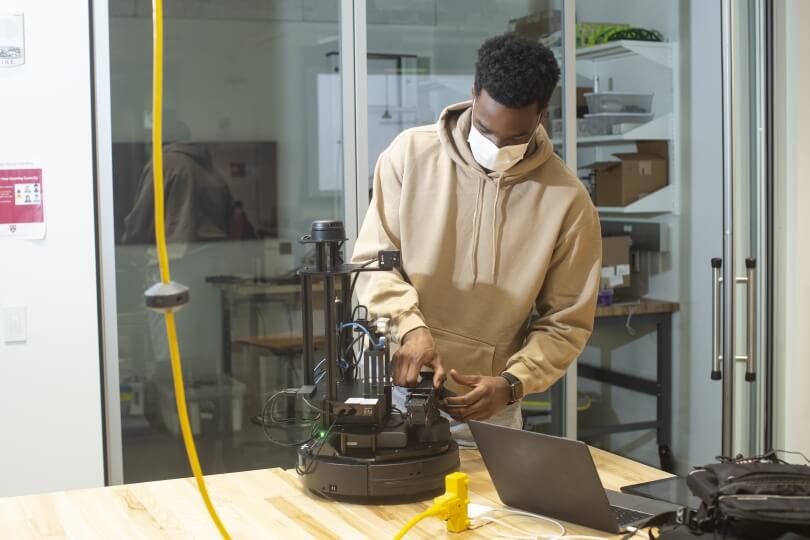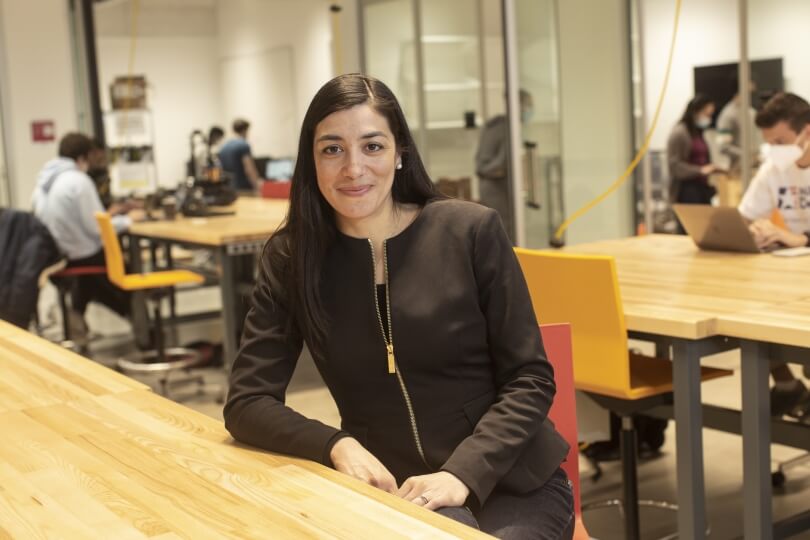News
You’re lost deep in the woods, surrounded by difficult terrain. It’s dark and cold, and all you have is a phone transmitting a WiFi signal. When your rescuers arrive, it’s not a search-and-rescue team, but a group of robots that have located your signal and mapped the ideal route to reach you.
Second-year student Emeka Ezike adjusts his robot during a "CS286: Multi-Robot Systems – Control, Communication, and Security" mini-hack in the Science and Engineering Comples. (Credit: Christopher Burns)
That’s the future students at the Harvard John A. Paulson School of Engineering and Applied Sciences (SEAS) are learning to design in “CS286: Multi-Robot Systems – Control, Communication, and Security.”
“Search and rescue pushes the envelope in terms of what we can do with robots and puts them in challenging situations, and it’s also a problem of great societal importance,” said Stephanie Gil, Assistant Professor of Computer Science at SEAS.
In CS286, Gil splits the students into teams. Each group is given a robot to work with provided by the Active Learning Lab.
Weekly workshops, known as “mini-hacks,” give students the opportunity to master the robot’s algorithms and operating system, and see their reading assignments in action. The final mini-hack took place March 25 in the Science and Engineering Complex. Students mapped a test environment with their robots’ on-board cameras and sensors, then used that map to remotely navigate the robots around simulated obstacles -- cones, blocks and partitions.
“Throughout the weeks you just get better at coding with the robot and controlling it, and it equips us with what we need to do the final project,” said Jun Chong, a third-year electrical engineering student with a secondary in computer science.
Many of the students in CS286 began the semester with little to no prior knowledge of robotics.
“The first mini-hack, I thought there was so much about the robot that I hadn’t learned before,” said Maegan Jong, a second-year student concentrating in CS. “But with that challenging introduction, it’s helped us gradually set up for the final project. Right now, I have much more familiarity with the system, and I do like how it’s very hands-on.”
Gil's development of the course and mini-hacks has been partially supported by her CAREER Award from the National Science Foundation, which she received in 2019.
The experience of a gradual accumulation of knowledge through the semester is exactly what she intends.
“For a lot of students, this was the first time they ever worked with robots,” she said. “We’ve made every mini-hack incremental, so it builds upon the previous one, and it teaches a new skill each time. My hope in the design of the course is that at the end of each mini-hack, they walk away feeling like they learned something new, and they feel more confident in their abilities with the robots.”
Diego Gutierrez, left, and James Arnold chat with teaching fellow Weiying Wang during a "CS286: Multi-Robot Systems – Control, Communication, and Security" mini-hack in the Science and Engineering Comples. (Credit: Christopher Burns)
SEAS students Maegan Jong, left, and Kevin Huang work with teaching fellow Ninad Jadhav in a "CS286: Multi-Robot Systems – Control, Communication, and Security" mini-hack in the Science and Engineering Comples. (Credit: Christopher Burns)
For Adolfo Roquero, a third-year CS student, directly applying the assigned research papers to hands-on work in the mini-hack made it much easier to master the technical skills.
“Even if you don’t know anything on a specific robotics topic, you read the paper, answer some questions about it, and then come to class and have it explained,” he said. “You do gain an understanding of how it works.”
While CS286 is an undergraduate course, some of Gil’s Ph.D. students in the REACT Lab (Robotics, Embedded Autonomy, and Communication Theory Lab) also attend the mini-hacks.
“There is documentation for different robots and software, but they’re scattered around the internet,” said Ph.D. student Sushmita Bhattacharya. “Sometimes something works, and sometimes it doesn’t, just like in any robot. But with this kind of instructor-led approach, the students have teaching fellows available, they have all the documentation in one place, and that’s a really nice way to take the first step towards building something bigger.”
Stephanie Gil, Assistant Professor of Computer Science and Director of the REACT Lab at SEAS. (Credit: Christopher Burns)
Search-and-rescue missions can never account for all the environmental factors that might impede success. A collapsed building could further collapse, or a heavy wind could knock over a tree, blocking a previously accessible path.
Gil said her class’s final project could similarly incorporate sudden environmental changes such as fog or smoke.
“We can run simulations in task-allocation or solving coverage problems in a well-defined area where the communication is perfect,” Roquero said. “But then we come here, and we see that all the measurements are noisy. The robot might slip a wheel on the ground, so you don’t really know where you are, and the trajectories aren’t perfect. This is the part of robotics that we’re not aware of necessarily when we’re reading the papers and implementing the algorithms. But we come here, and we see it.”
As long as the students correctly implement what they’ve learned, their robots will handle whatever Gil throws at them.
“There’s a big difference between doing something in simulation versus in hardware versus taking it into the real world,” Gil said. “I’ve really pushed them throughout the semester to think about how the sensors on their robots can be compromised, and how the algorithms should still be able to adapt and be robust in these situations.”
Topics: AI / Machine Learning, Allston Campus, Computer Science, Robotics
Cutting-edge science delivered direct to your inbox.
Join the Harvard SEAS mailing list.
Press Contact
Matt Goisman | mgoisman@g.harvard.edu






